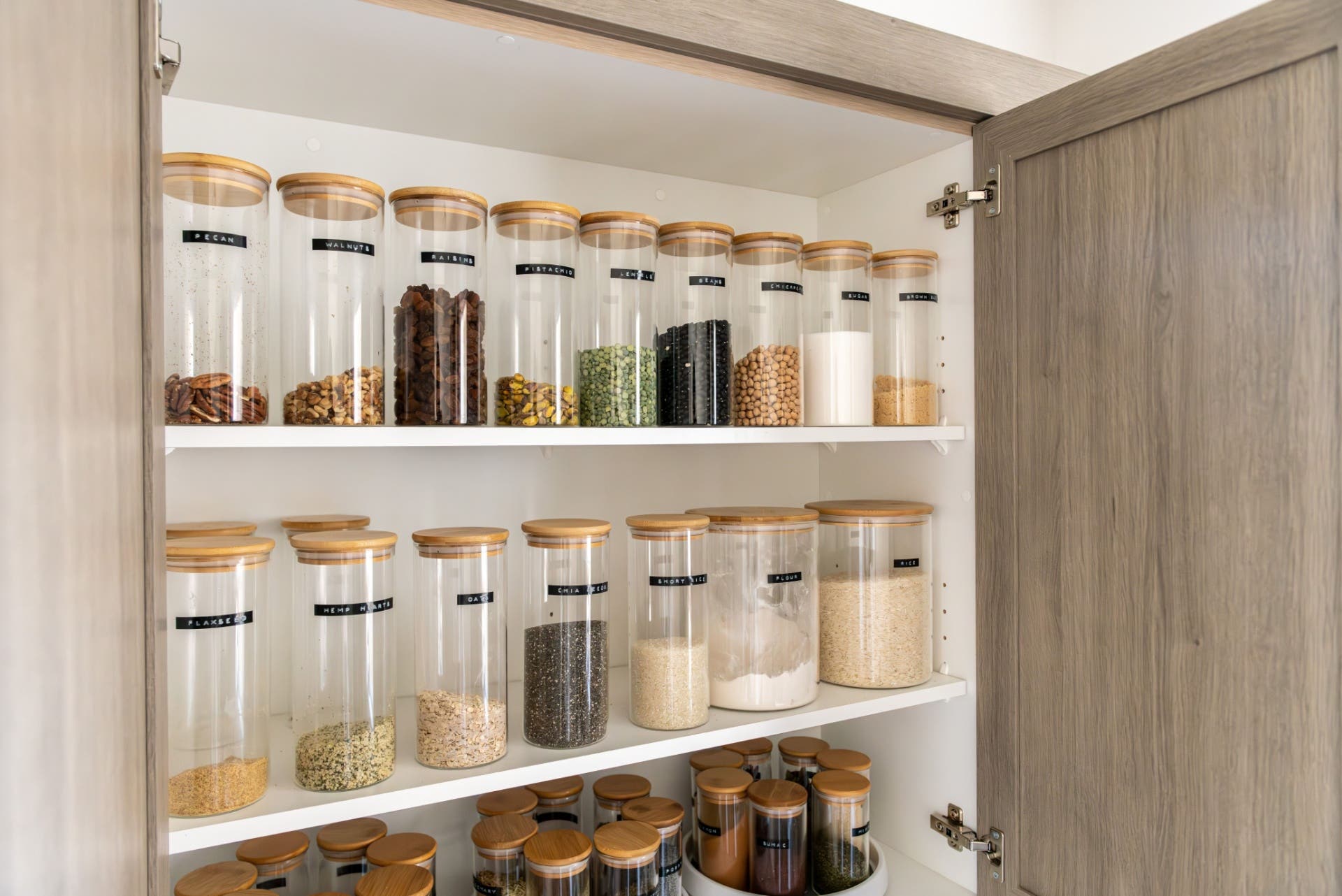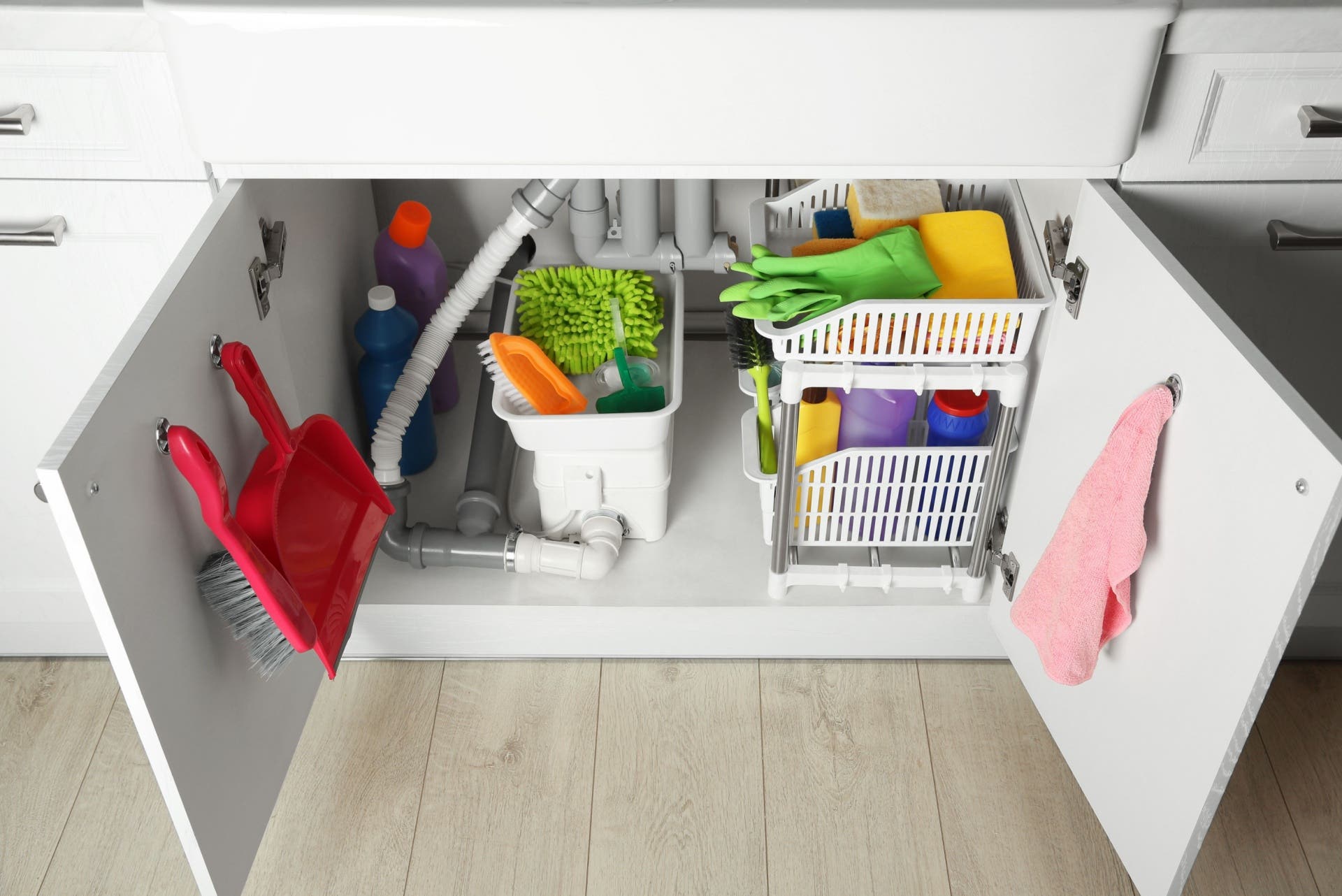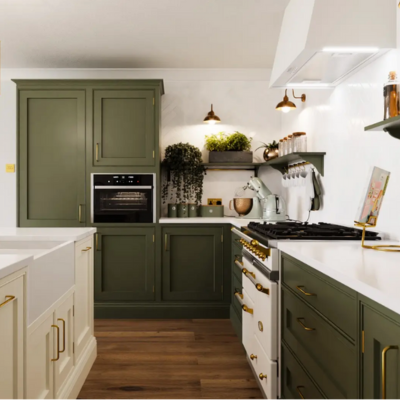Is your kitchen feeling cluttered and chaotic? Do you struggle to find what you need among piles of dishes, ingredients and pantry items? If so, it’s time for a kitchen makeover.
Rehome’s 16 tips for organising kitchen cabinets are all about regaining control over your supplies. After all, a clean kitchen is a happy one!
To learn more about the importance of decluttering and storage management, stay with Rehome: the UK’s number one Kitchen, Bedroom, Bathroom outlet.
1. Create a logical layout
What’s the key to creating efficient storage systems?
Being practical! The only way to create a kitchen that truly works for you is by organising logically. For easy access, store your cleaning supplies in the undersink cabinet.
Your wall and base cabinets should be home to items involved in food preparation, utensils, and even small appliances. Any seasonings you use regularly could be kept in a spice rack placed on your kitchen counter.
Any perishable items can be stored in full-height cabinets, and the foods you’re stocking up on can be kept higher up. It’s this type of practical, systematic storage system that will make accessing your goods easier.
2. Glass kitchen cabinets
One way to make sure your cabinets are always tidy is to have them on display! Glass-fronted doors allow you to see everything inside your cabinets and can also make organising them easier.
Particularly suited to cookware, try stacking your plates from largest to smallest, creating displays with bowls and relocating items that take up too much space to a different location.
Line up your mugs in neat rows, or even create shelves within shelves!
3. Kitchen drawers
There’s truly nothing worse than rooting around your cluttered kitchen drawers. Pull-out drawers are one of the first places where miscellaneous items start to accumulate. Most often, because we don’t actually know what’s in there!
Keep your kitchen drawers in tip-top shape by stripping everything back. Start by removing all your items, any organisers, utensils or ingredients. See what you can keep and what’s ready for the bin. Then, move on to the next step!
Drawer organisers are a game-changer only if you keep them tidy. Give everything a home within your drawer, and anything that doesn’t quite fit, leave on your worktop until you find another useful place for it.
4. Use vertical space
Thinking vertically is another great kitchen organisation tactic. More often than not, homeowners struggle to find room in their cupboards and drawers without realising the obvious: there’s a whole world of possibilities in your unused, vertical spaces!
For example, with the right equipment, you can install additional shelves within your cabinets. Many cabinets have large gaps between existing shelves, which can lead to a lot of wasted potential.
An easier option may be to incorporate door-mounted storage into your cabinets. As an overlooked area, the inside of your cabinet doors is a prime spot for storage. You can attach racks or hooks to store spices, cleaning supplies, or kitchen tools!
5. Group items together
Knowing what you have and where it is the ultimate goal for any homeowner, particularly when it comes to the kitchen. But it’s easier said than done!
You can take stock of your supplies by grouping items. Doing so allows you to see at a glance what you have, what you need to throw away (e.g., out-of-date items), and any duplicate products.
How you choose to categorise items is up to you, but a fail-safe strategy is to link items based on their usage.
For example, store all baking supplies like flour, sugar, and baking powder together so that when the inevitable urge to bake arises, everything you need is all in one place!


6. Under-sink cabinet
The under-sink cabinet might seem like an unremarkable area of your kitchen, but it’s actually one of the most valuable. Its proximity to the sink means it’s the perfect place for storing chemical cleaning products.
To organise this area, start by laying an absorbent mat on the cupboard floor: this will help manage any leaks or spills and keep the area dry and easy to clean. Then, using clear, stackable storage bins, begin arranging your products.
For example, store all dishwasher tablets and rinse aids in one bin and group all your everyday cleaning supplies like sponges, cloths, and sprays in another.
7. Set up a recycling zone
Sometimes, keeping your cabinets organised may involve making additional investments in general cleanliness. For example, dedicating a storage bin specifically for recycling!
Invest in a multi-compartment recycling bin and place it near your main workspace (e.g., the food prep area or sink): this way, you can immediately dispose of packaging materials.
Or, if you’ve got the space and budget, purchase several smaller bins to separate different types of recyclables, such as paper, plastic, glass, and metal.
8. Purge and declutter
Over time, most kitchens tend to accumulate a variety of items, many of which go unused. That’s why a complete purge may be the best way to get started!
Empty your cabinets entirely and clean the shelves thoroughly before putting anything back. As you sort through your items, group them into categories such as bakeware, utensils, and food storage containers.
As you declutter, consider the usefulness and condition of each item. Discard anything that is broken, missing parts, or rarely used. Items that are still in good condition but no longer needed can be donated!


9. Create a pantry
If you’re someone who loves cooking homemade meals from scratch, your ingredients cabinet is likely bursting at the seams! Pantries can rectify this issue by being a dedicated space for all your cooking supplies.
Pick a space in your kitchen, whether it’s an existing cabinet or a wall, with plenty of room for one of our freestanding pantries, and give it a thorough clean. To maximise storage, use stackable containers, clear jars, and baskets.
Decant pantry staples, like cereals, rice and pasta, into these clear jars so you can see exactly when it’s time to restock (plus, it looks great!)
10. Label storage containers
Once you’ve created a dedicated pantry area, labelling your storage containers can help keep them clean permanently.
Using chalkboard labels or whiteboard pens is practical because they allow you to update the labels as the containers' contents change. Permanent labels, however, are ideal for organising staple items like flour, sugar, and rice.
Colour-coded labels can also be effective, especially for distinguishing between different types of food or ingredients quickly. You could use blue labels for dry goods, green for spices, and red for baking ingredients!
11. Use hooks
The backs of your cabinet doors are perfect for hanging lightweight items.
Command hooks, particularly, are easy to install and remove without damaging surfaces. Simply clean the surface, let it dry, and then apply the hooks according to the instructions.
You can use this method for hanging items such as measuring cups, spoons, and small kitchen tools that often clutter drawers. For heavier items, like pot lids or cutting boards, you’ll need to use reinforced hooks.
Another prime location for hooks is under the sink! Hang cleaning supplies, such as spray bottles, brushes, and dish towels, on the cabinet door: ready for when you need them.
12. Use slot-in racks for cookware
Slot-in racks function similarly to toast racks, by letting you store items vertically. If you’re someone who falls victim to ‘stacking’, accessing your cookware or utensils can be a significant hassle.
But by storing each item individually in a slot-in rack, you can reduce the risk of damaging your cookware whilst keeping everything within sight.
Installing these racks is straightforward: they can be placed inside cabinets or pantries, and some are even designed to fit under shelves! Slot-in racks can also help you organise flat items like baking trays, cutting boards, and lids, which often end up piled together.
13. Open shelving
Replacing some or all of your upper cabinets with open shelves can make clutter harder to ignore.
With everything on display, you can quickly grab the items you need without having to open cabinet doors or search through cluttered spaces. Plus, you’re more likely to hold yourself responsible for cleaning any mess that’s built up over time.
However, it’s a good idea to consider maintenance if you’re switching to open shelving. Items on open shelves are exposed to dust and grease from cooking, so they’ll require regular cleaning.
14. Wine bottle organiser
No one wants bottles scattered around their kitchen. To give each vintage a dedicated home, measure the dimensions of your current cabinets and find an organiser that slots right in!
You can do this if you have a limited amount of floor space, or, you can keep a taller vertical wine bottle organiser close to your kitchen island.
By keeping your wine collection close to where you might be entertaining guests or preparing meals, you can conveniently grab a bottle without moving around too much!
15. Declutter utensils
As we collect cookware for our kitchens over time, it becomes necessary to discard utensils that might be damaged, unusable or simply don’t serve a purpose in our homes any more.
Start by gathering all your spatulas, whisks, and measuring spoons in separate piles. Once you see how many of each type you have, it becomes easier to determine which ones are truly necessary and which can be donated or discarded.
Or, you can use the 12-12-12 challenge, which involves selecting 12 items to throw away, 12 to donate, and 12 to keep! Breaking down decluttering into more manageable steps can help you make quicker decisions without feeling overwhelmed.


16. Dishes in cabinets
When it comes to kitchen clutter, there’s no doubt that dishes are one of the hardest things to keep clean.
Whether it’s not letting dirty ones pile up by the sink or struggling to find a place to put them, having an organised system for dish storage can make all the difference.
Take inspiration from our wine rack idea and install plate racks within your cabinets: you can pull out any dish you need from this vertical storage system without disturbing the entire stack!
Or, you can invest in adjustable shelves: by moving the side pegs, you can customise the height of each shelf to accommodate dishes of different sizes!
Shop for second-hand kitchens with Rehome!
Keeping your kitchen cabinets tidy is easier said than done. But with the right tools and knowledge, anything is possible. Live in this possibility with Rehome, and give your kitchen the upgrade it deserves. Homeowners working with a tight budget can browse our highbrow selection of luxury, ex-display kitchens. With premium brands like Tom Howley, Smallbone of Devizes, and John Lewis on offer, you can get your ideal decor for thousands of pounds less than high-street prices.














